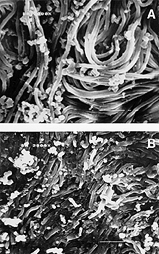ANTHRAX: The Prokaryote
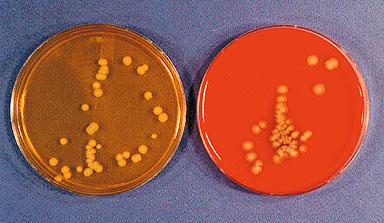
Figure 1. Anthrax colonies growing on 3AT medium (left) and blood agar (right) |
Figure 2A. (Top) Scanning electron micrograph of anthrax bacteria from ordinary medium (18-24 hours) Figure 2B. (Bottom) Scanning electron micrograph of anthrax bacteria from 3AT medium (5-6 hours) |
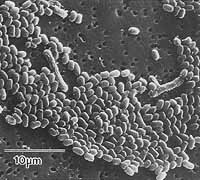 Electron micrograph of
Electron micrograph ofBacillus anthracis spores. Photograph courtesy of USAMRIID |
If caught early enough following exposure, treatment with antibiotics is usually successful.
Pathogens
Humans, and our domestic animals, can serve as hosts to a wide variety of disease-causing organisms (pathogens):- bacteria
- viruses
- fungi
- protozoans
There are many chemicals that are lethal to bacteria - cyanide does a good job - but they cannot be used to cure infections because they are lethal to the host as well
The problem, then, is to find substances that attack a metabolic pathway found in the bacterium but not in the host. This is not an insurmountable problem for bacterial pathogens because prokaryotes differ in many respects from eukaryotes.
The Solution - Antibiotics.
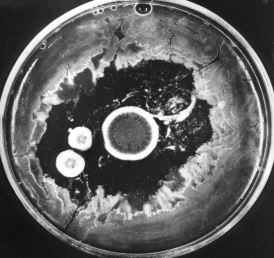
- Natural products. A number of natural products, penicillin for example, have been discovered that are antibiotics suitable for therapy. They were originally discovered as secretions of fungi or soil bacteria.
The photo (courtesy of Merck & Co., Inc.) shows how the growth of bacteria on the agar in a culture dish has been inhibited by the three circular colonies of the fungus Penicillium notatum. The antibiotic penicillin, diffusing outward from the colonies, is responsible for this effect
The Chink in the Armour = the bacterial cell wall
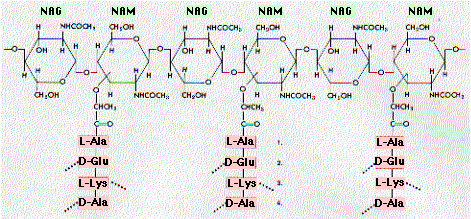
Some antibiotics work by interfering with the synthesis of the bacterial cell wall - a structure that is not found in eukaryotes. The walls of bacteria are made of a complex polymeric material called peptidoglycan. As its name suggests, it contains both amino acids and sugars.
Antibiotics bind to and inhibit enzymes needed for the synthesis of the peptidoglycan wall. While they have little effect on resting bacteria, they are lethal to dividing bacteria as defective walls cannot protect the organism form bursting.
Questions
- Why can't we use Cyanide to kill Anthrax?
- What is the part of the prokaryote cell that penicillin attacks?
- Why does it only affect growing bacteria (prokaryotes)?
- Why doesn't Penicillin kill people ?
- What organisms naturally produce Penicillin?
- How does the Anthrax die? Can you explain why?
